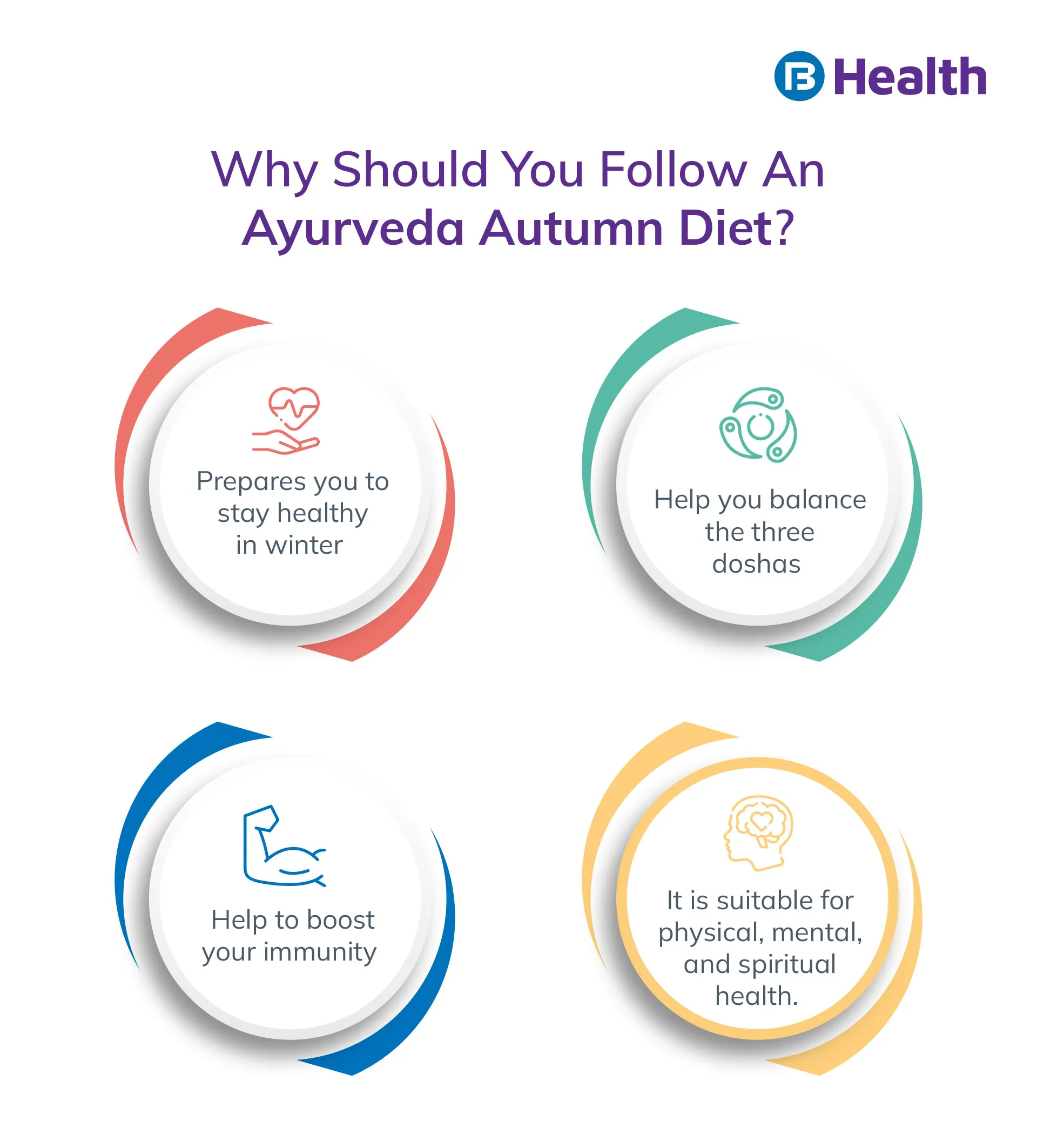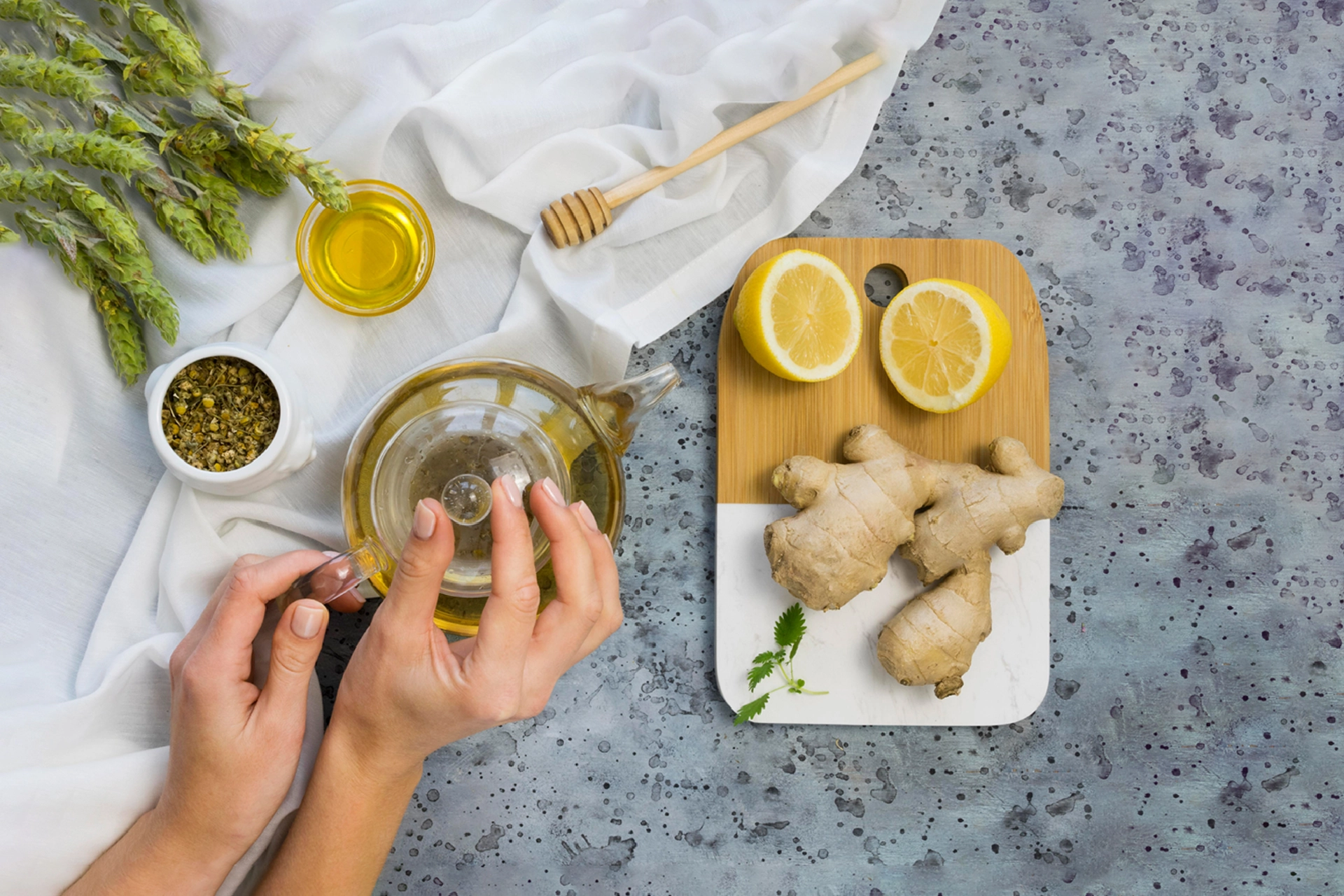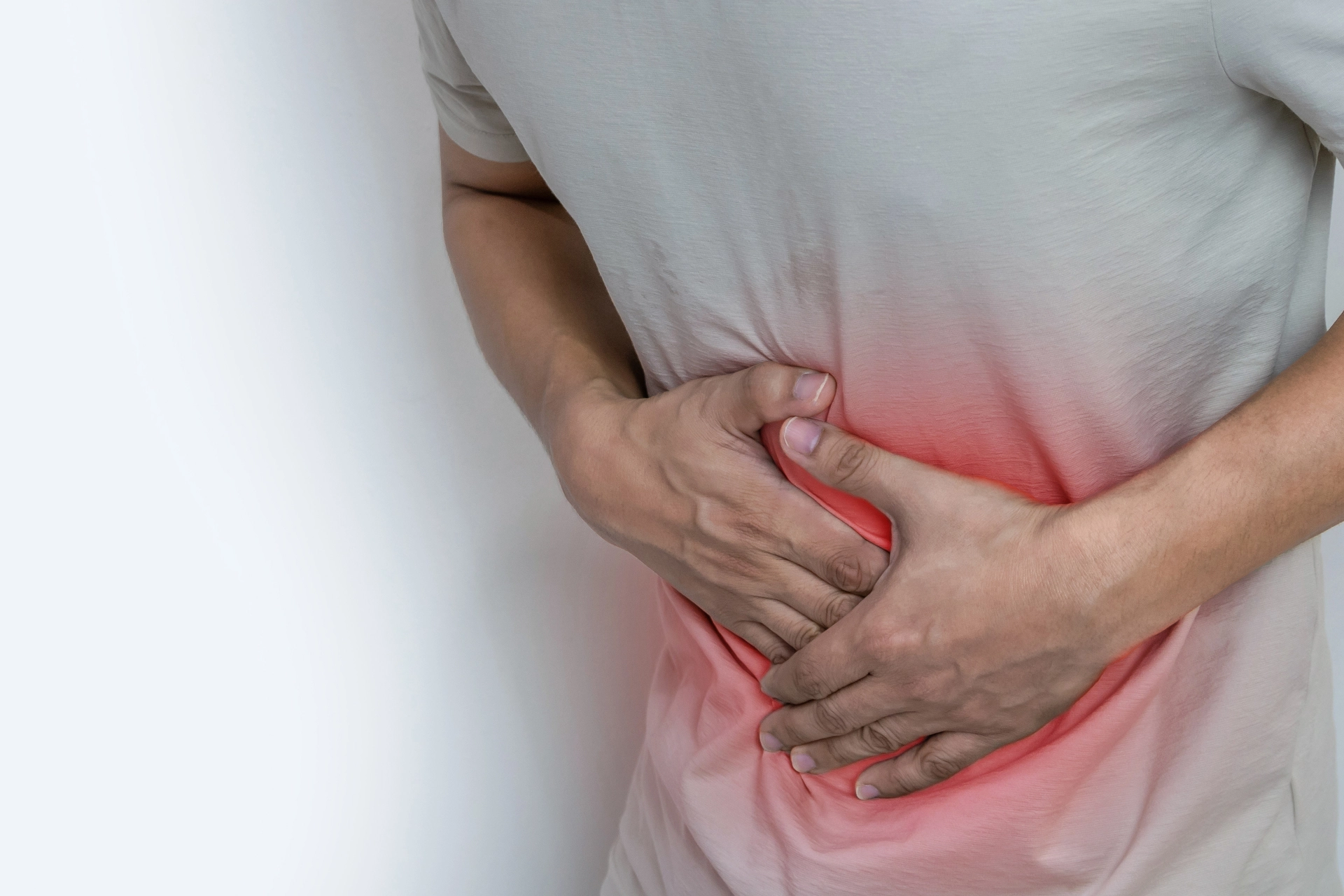Ayurveda | 7 min read
Ayurveda Autumn Diet: Ayurvedic Tips to Stay Fit and Healthy
Medically reviewed by
Table of Content
Synopsis
Ayurveda divides a year into three seasons, each dominated by a dosha. These doshas are, in turn, classified as Pitta (hot and moist), Vata (dry and cold), and Kapha (heavy and oily), with specific characteristics to maintain balance. Learn about sustaining balance through the Ayurveda Autumn Diet for good health during the transition to winter.
Key Takeaways
- The three doshas affecting everyone’s health are Pitta, Vata, and Kapha
- The best Ayurveda Autumn Diet blends the seasonal Pitta and Vata foods to attain a balance
- Ingesting nutritious food based on Ayurvedic principles alongside Yoga is the key to good health and lifestyle
Autumn is when the earth loses its heat accumulated during the summer months leading to dryness around us. According to Ayurveda, the earth cools when the wind blows, and the leaves wither. So, it provokes all pervading qualities like roughness, dryness, lightness, mobility, and coolness in the atmosphere affecting us by triggering the Vata dosha. Since the Vata force drives other doshas, any imbalance reflects in it also. But the Ayurveda Autumn Diet helps the body insulate itself from heat loss by drawing blood to the core. Consequently, our body’s extremities, without access to blood, turn dry, while the blood-rich center improves appetite to nourish the skin with a fresh layer of fat in readiness for winter. But before we delve any further, let us dig deeper into Ayurvedic concepts and explore the suggested diet.
What Are The Basics Of Ayurvedic Healing?
Ayurveda is an ancient Indian holistic healing system derived from Sanskrit, “the science of life.” The 5000 years old belief states that good health is the outcome of the balance between mind, body, and spirit comprising five elements – air, ether (space), fire, water, and earth. So, it is a vast assembly of complementary practices encompassing every person’s health and lifestyle. Ayurveda focuses on an individual approach to optimal health.
Our fast-paced lifestyle frequently triggers Vata imbalance during autumn resulting in dry skin, constipation, and insomnia. Ayurveda brings laws of nature into play to prevent the outcome of dryness and mobility, the two most common symptoms during the season. So, moisture balances dryness, slowing down balances mobility, and warmth balances coolness. These simple concepts, yet profound alongside its sister science, Yoga, Ayurveda ensures physical, mental, and spiritual health.
Understanding Doshas To Seek Balance With Energetics
Ayurvedic doctors and practitioners use a classification system based on complementary qualities like hot/cold, dry/moist, light/heavy, etc. For example, food classification on what feeling the herb generates – ginger is hot, melon is moist, and cooked grains are heavy. The concept is the basis of an extensive structure of “energetics” that includes all metabolic actions. So, the sensory experiences condense into three metabolic master forces called “doshas.”Doshas comprise energies intrinsic to each master force and are responsible for a balance promoting and sustaining an individual’s lifelong health. To make the concept simple, let us consider Vata dosha. It signifies dry, cold, and light energies. Similarly, Pitta dosha signifies hot, wet, and light, while Kapha dosha causes cold, wet, and heavy. According to Ayurveda, the disease is an imbalance of doshas, and every person’s action impacts their balance.

What Are The Characteristics Of Vata: The Dosha Of Wind?
Ayurveda divides the year into three seasons with a predominant dosha for each. So, Pitta is warm and moist, Vata is dry and cold, and Kapha is heavy and oily. The Vata season sets in late autumn in October, combining the elements of air and space, and the characteristics are cold, dry, light, and quick-moving. Moreover, the qualities of Vata dosha are positive and negative.
- Positive qualities during Vata dosha:
- Creativity
- High energy
- Enthusiasm
- High tolerance
- Good temper
But autumn or fall is also the time of transition combining Pitta in early autumn and Vata in late autumn. And everyone is susceptible to imbalance showing signs of the following:
- Negative qualities during Vata dosha:
- Anxiety
- Inability to concentrate or perform
- Insomnia
- Gas or bloating
- Dry skin and hair
- Weight loss
It is to everyone’s benefit that the Vata dosha remains balanced during autumn as it gets aggravated with the cold weather. However, according to Ayurveda, “like qualities increase other like qualities,” and persons with Vata dispositions are vulnerable to Vata excess during late autumn and winter. So, it is best to control it before extreme conditions lead to perpetual fatigue or spacey.
But blending the qualities of Kapha (heavy and oily) and Pitta (warm and moist) with Vata (dry and cold) through food and beverages remove imbalances within the body. Thus, one must attain sattva (balance) by ingesting seasonal foods associated with Pitta in early autumn and Vata in late autumn. Moreover, an increased appetite encourages eating well to bolster the proper antidote to balance the transition from the summer Pitta to winter Vata.
Additional read: Useful Ayurveda Tips to Cope With the Monsoons
How To Create A Supportive Ayurveda Autumn Diet?
Maintaining internal equilibrium throughout is critical to counter the effects of each season, as defined in Ayurveda. The science of life follows the principle of “opposites balance,” and Ayurveda tips help you choose the proper diet and lifestyle to prevent imbalance. Nothing is better than choosing an Ayurveda fall diet to soothe Vata this season despite the urge to increase food intake. But it is sensible at the same time to follow the lead of appetite and digestion, even online doctor consultations to avoid excess. Moreover, prevent fasting, as Vata needs adequate nourishment for the desired equilibrium. So, what are the Ayurveda tips [1]? Let us find out.
Early fall
The period from mid-September to late October is the transitional stage of autumn. It is the time when the best Ayurveda Autumn Diet comprises fresh and late-summer fruits. So, feast on apples and pears to dry out excess Pitta from summer. Apples are fiber-rich, priming the gut for digesting heavier winter foods. Other ideal food options are eggplant, corn, melons, figs, and okra. Insufficient drying induces excessive mucous production to trap leftover summer, Pitta. It is the storehouse for virus infections causing flu and common cold in late fall and early winter.
Late fall
It is essential to balance Vata foods with fluids during the late fall’s pronounced dosha. In addition, the blend promotes warmth, moisture, and grounding in sweet, oily, spicy, heavy, or salty foods. So, let us check them out.
- Fruits like banana, avocado, tomato, citrus, cooked apples, and pears
- Steamed vegetables, including squash, potato, turnip, pumpkin, and yam
- Grains like rice, wheat, and oats
- Ghee, butter, and olive oil
- Most whole nuts
- Warm spices like cardamom, cinnamon, nutmeg, ginger, and cloves
- Warm fluids, including lemongrass tea and mint tea
- Animal and vegetable proteins
What Foods To Favor For The Ayurveda Autumn Diet?
The Vata season needs nutritious foods that are protein and fat-rich, enlivened with warm, stimulating spices, and served hot. The recipe is ideal for sustaining the internal moisture reserves keeping you grounded during the Vata months. So, the best Ayurveda Autumn Diet must contain the following:
- Soft foods with sweet, sour, and salty tastes generously garnished with ghee or oil
- Cooked grains like oatmeal, tapioca, cream of rice, or wheat are best for breakfast
- Steamed vegetables, nourishing grains, soups, and stews for lunch and dinner help retain moisture balance
- Autumn is the best time to gorge on meat and fowl eggs
- Dairy products, nuts, and seeds should round off the Ayurveda fall diet.
Coming this far in understanding various aspects of the Ayurveda autumn diet, let us look at the different foods to consider for balancing Vata dosha.
| Food Class | Food Name |
| Fruits | Cooked apples, avocadoes, bananas, dates, figs, grapefruit, grapes, limes, mangoes, oranges, tangerines, papayas, soaked prunes, and raisins |
| Vegetables | Beets, carrots, chilies, garlic, onions, pumpkins, squash, sweet potatoes, and okra |
| Grains | Basmati and brown rice, amaranth, oats, quinoa, and wheat |
| Legumes | Kidney beans, moong beans, toor, and urad daal |
| Dairy | Butter, buttermilk, cheese, cream, kefir, hot milk, and sour cream |
| Animal products | Eggs, mutton, beef, buffalo, venison, chicken, duck, turkey, fish, lobster, shrimp, crab, and oysters |
| Oils | Ghee, almond oil, peanut oil, olive oil, sesame oil, and safflower oil |
| Sweeteners | Honey, jaggery, maple syrup, molasses, rice syrup, and sugar |
| Spices | Ginger, garlic, turmeric, saffron, oregano, paprika, cardamom, cinnamon, clove, cumin, black pepper, mustard, anise, allspice, parsley, nutmeg, dill, asafoetida (hing), bay leaf, basil, and rosemary |
How about sampling a few Ayurveda Autumn Diet recipes after learning about the foods that can keep the Vata imbalance at bay? So, here we go.
Breakfast
- Seasoned warm oats with pumpkin pie sauce and almond butter
- Sliced green apples raw or sauteed with ghee depending on the season
Lunch
- White or brown rice
- A protein of the individual’s choice
- Sauteed acorn squash in olive oil
- Warm clove chai or tea
Dinner
- Boiled vegetable soup containing stewed tomatoes, rice or pasta, and broth with curry seasoning, salt, pepper, and spices to taste
- Ghee or lightly buttered crusty bread
- Ginger chai or tea
Autumn, the season of transition, is dry, rough, erratic, but windy and clear, which are the qualities defined as Vata dosha in Ayurveda. Since science focuses on balance as the measure of good health, the Ayurveda Autumn Diet is ideal for achieving it. So, gain all the insight you need into autumnal foods to favor at Bajaj Finserv Health and enjoy the season with good health and humor and maintain the sattva without losing flavors.
References
- https://chopra.com/articles/autumn-eating-ayurvedic-tips-for-fall
Disclaimer
Please note that this article is solely meant for informational purposes and Bajaj Finserv Health Limited (“BFHL”) does not shoulder any responsibility of the views/advice/information expressed/given by the writer/reviewer/originator. This article should not be considered as a substitute for any medical advice, diagnosis or treatment. Always consult with your trusted physician/qualified healthcare professional to evaluate your medical condition. The above article has been reviewed by a qualified doctor and BFHL is not responsible for any damages for any information or services provided by any third party.





